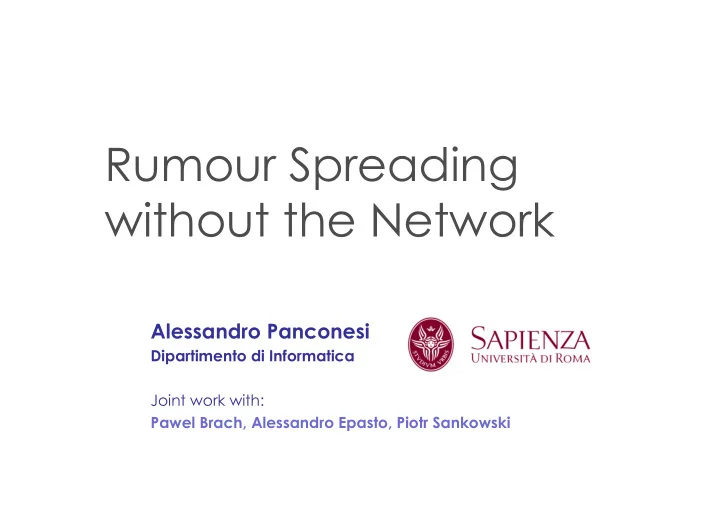

Rumour Spreading without the Network Alessandro Panconesi Dipartimento di Informatica Joint work with: Pawel Brach, Alessandro Epasto, Piotr Sankowski
THE ¡STARS ¡
PEOPLE ¡
The ¡INTERNET ¡is ¡an ¡observatory ¡of ¡Crowds ¡
Digital ¡Traces ¡
The ¡Grand ¡Challenge ¡
The Grand Challenge What can we reconstruct the original diffusion process from the huge, and yet scanty, digital traces?
Rumour spreading, a case study
Gossip: a very simple model
Gossiping
Gossiping
Gossiping
Gossiping
Gossiping
Gossiping
Gossiping
Gossiping Variants PUSH Node with information sends to a random neighbour
Gossiping Variants PUSH Node with information sends to a random neighbour PULL Node without information asks a random neighbour
Gossiping Variants PUSH-PULL PUSH Node with information sends to a random neighbour PULL Node without information asks a random neighbour
The problem that we want to solve RUMOUR SPREADING WITHOUT THE NETWORK
Beyond ¡the ¡asymptoBc ¡tradiBon ¡ Can we predict the number of informed nodes at time t on the basis of the degree distribution alone?
Beyond ¡the ¡asymptoBc ¡tradiBon ¡ Can we predict the average number of informed nodes at time t on the basis of the degree distribution alone?
Beyond ¡the ¡asymptoBc ¡tradiBon ¡ Can we predict the average number of informed nodes at time t on the basis of the degree distribution alone for real social networks ?
The Master Plan
The master plan • Develop in a rigorous way a space- efficient simulator for a model • Test it with real networks
THE MODEL
Configuration Model D = ( )
Configuration Model D = ( )
Configuration Model D = ( )
Configuration Model D = ( )
Configuration Model D = ( )
Configuration Model D = ( )
Configuration Model D = ( ) Is this a good model for social networks?
Configuration Model D = ( ) Is this a good model for social networks? No, but this is good!
Problem ¡restatement ¡ Can we predict the average number of informed nodes at time t on the basis of the degree distribution alone for the configuration model ?
Problem ¡restatement ¡ Can we predict the average number of informed nodes at time t on the basis of the degree distribution alone for the configuration model ? YES, OF COURSE!
Naive Simulator • On input D = (d 1 ,d 2 ,…,d n ), pick a random graph G(D) from the configuration model • Pick a random source and simulate rumour spreading • Compute averages • Repeat
THE SPACE-EFFICIENT SIMULATOR
The Efficient Simulator D = ( )
The Efficient Simulator D = ( )
The Efficient Simulator D = ( )
The Efficient Simulator D = ( )
The Efficient Simulator D = ( )
The Efficient Simulator D = ( )
The Efficient Simulator D = ( )
The Efficient Simulator D = ( )
The Efficient Simulator D = ( )
The Efficient Simulator D = ( )
The Efficient Simulator D = ( ) This is space-efficient because we do not need to keep the stubs, only their number
The Efficient Simulator D = ( ) For undirected networks further optimization is possible. The resulting savings are spectacular
Dealing with aggregates Rank(u) = #unused stubs of node u M[i,j] = #nodes of degree j and rank j DxD matrix
Dealing with aggregates
Theorem • The Efficient Simulator is a correct implementation of the Naïve Simulator-- they compute the same averages
A Picture is Worth a Thousand Words
EXPERIMENTS WITH REAL NETWORKS
Experiments ¡with ¡real ¡networks ¡ ? Input: ¡the ¡degree ¡ Efficient ¡simulator ¡for ¡ distribuBon ¡of ¡a ¡real ¡ the ¡configuraBon ¡model ¡ network ¡
The Good.. Epinions
The Good..
The Bad..
and the Ugly
Different behaviours • Friendship and trust networks: Epinions, Facebook, LiveJournal, RenRen, and Slashdot • Collaboration and Email networks: AstroPh, CondMatt, DBLP and WikiTalk; EuAll and Enron • Non-social newtorks: Web, Amazon
Courtesy of Silvio Lattanzi MEASURING RANDOMNESS
Sudden drops
To summarize • We developed a space-efficient predictor for the configuration model • Surprisingly, this works quite well for real social networks too
Future work • Look for more efficient predictors, eg systems of differential equations • Go beyond averages • Extend to other diffusion processes?
THANKS
Recommend
More recommend